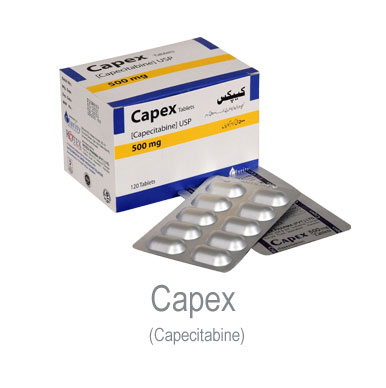
Capex
(Capecitabine)
Composition:
Each film-coated tablet contains 500mg capecitabine
ATC Code
Structure

Description
Indication
- Colorectal Cancer
Associated Conditions
- Duke’s C Colon cancer
- Esophageal Neoplasms Malignant
- Metastatic Breast Cancer
- Metastatic Colorectal Carcinoma
- Pancreatic Metastatic Cancer
- Fallopian Tube Carcinoma
Pharmacodynamics
Absorption
Readily absorbed through the GI tract (~70%)
Peak Plasma Time
1.5 hr (capecitabine); 2 hr (5-FU)
Protein binding
Protein bound: <60% (primary to albumin ~35%)
Metabolism
Metabolized by thymidine phosphorylase to fluoruracil.
Hover over products below to view reaction partners
Capecitabine
5’-Deoxy-5-fluorouridine
5-fluorouracil
Route of elimination
Capecitabine and its metabolites are predominantly excreted in urine; 95.5% of administered capecitabine dose is recovered in urine. Fecal excretion is minimal (2.6%). The major metabolite excreted in urine is FBAL which represents 57% of the administered dose.About 3% of the administered dose is excreted in urine as unchanged drug.
Half-life
0.75 hr (parent capecitabine and 5-FU)
Mechanism of Action
Fluoropyrimidine carbamate with antineoplastic activity; it is a prodrug of 5’-deoxy-5-fluorouridine (F’-DFCR), which is then converted to 5-fluorouracil (5-FU)
Both normal and tumor cells metabolize 5-FU to 5-fluoro-2’-deoxyuridine monophosphate (FdUMP) and 5-fluorouridine triphosphate (FUTP)
Product Information
Share This Story, Choose Your Platform!
